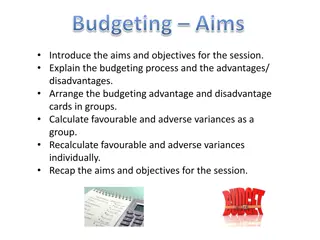Understanding Capital Budgeting Decisions and Investment Strategies
Capital budgeting decisions involve long-term investments in assets to generate anticipated future benefits, with high risk and long periods between outlay and return. They are crucial for firm growth, asset allocation, and risk management. Different types of investment decisions like expansions, diversification, and modernization play a key role in the capital budgeting process, which includes identifying proposals, evaluating cash flows, and prioritizing investments for long-term success.
Download Presentation

Please find below an Image/Link to download the presentation.
The content on the website is provided AS IS for your information and personal use only. It may not be sold, licensed, or shared on other websites without obtaining consent from the author. Download presentation by click this link. If you encounter any issues during the download, it is possible that the publisher has removed the file from their server.
E N D
Presentation Transcript
Capital Budgeting Decisions_ Payback Period DR. JAMES MATHEW
The investment decisions of a firm are generally known as capital budgeting or capital expenditure decisions. Long term Investment Decisions (Capital Budgeting Decisions) Capital budgeting decision may be defined as the firm s decision to invest its funds in the long term assets in anticipation of an expected flow of benefits over a number of years. It involves a current outlay or series of outlays of cash resources in return for an anticipated flow of future benefits.
Features Features Exchange of current funds for future benefits Funds are invested in long term assets Future benefits will accrue over a series of years There is relatively high degree of risk There is relatively long period between the initial outlay and the anticipated return
Importance of Capital budgeting Decisions Importance of Capital budgeting Decisions Capital budgeting decisions are important because of the following reasons: They influence the growth of the firm Substantial Expenditures Long term periods: The effects of the decision will be felt over a long period of time. They have long term consequences influencing the rate and growth of a firm. High Risk Irreversibility Complexity
Types of Investment Decisions Types of Investment Decisions Different ways to classify investment decisions. Expansions Diversification Replacement and Modernization Research and Development Another Classification Mutually exclusive investments Independent investments Contingent of Dependent investments
Capital Budgeting Process Capital Budgeting Process Identification of investment proposals Screening the proposals Estimation of cash flows Evaluation of proposals Fixing priorities Final approval and preparation of capital expenditure budget Implementing proposal Performance review
Traditional Methods Methods of Methods of Capital Capital Budgeting Budgeting Time Adjusted Methods or Discounted Methods
Traditional Traditional Methods Methods Payback period method Rate of return method
Net present value method Time Adjusted Time Adjusted Methods or Methods or Discounted Methods Discounted Methods Internal rate of return method Profitability index method
Payback Period Method Payback Period Method The number of years required to recover the original cash outlay invested in a project. Payback period = Initial investment/ Constant annual cash inflow Incase of unequal cash inflows, payback period is found out by cumulating cash inflows until the cash inflows equal the initial cash outlay. Acceptance Rule The shorter the payback period, the more desirable is the project. Firms generally specify the maximum acceptable payback period.
Advantages Advantages Simple to understand and easy to calculate Costs less than other methods It is a rough and ready method for dealing with risk. It reduces the risk of loss through possible obsolescence Suitable for firms having shortage of cash or liquidity problems.
Limitations Limitations It fails to consider the time value of money It ignores cash flows beyond the payback Does not consider cost of capital which is an important factor in making sound investment decisions Determining a minimum acceptable payback period is a subjective decision. It is a measure of a project s capital recovery, not profitability.
Popularity of Payback Method Popularity of Payback Method Popular because of the following reasons: Simplicity A company can have more favourable short run effects on EPS by accepting projects with shorter payback period The riskiness of the project can be tackled by having a shorter payback period. The emphasis in payback is on the early recovery of investment thereby giving an insight into the liquidity of the project.























